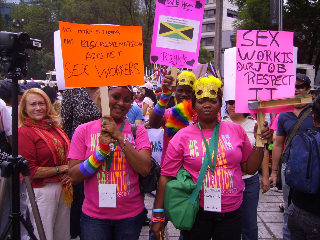
An article by Reynaga, E. in the HIV/AIDS Policy Law Review, 2008 Dec;13(2-3):97-8. It is accompanied by a PowerPoint presentation of Elena Reynaga’s plenary address at the International AIDS Conference.
An article in AIDS Care.
Sexual behaviour studies are often challenged by sampling, participation and measurement biases, and may be unacceptable to participants. We invited 293 randomly selected female sex workers (FSWs) in Bangalore, India, to participate in a telephone survey, with condom breakage as the main outcome. Free cell phones were supplied and trained interviewers telephoned FSWs daily to ask about all sex acts the previous day.
Article in BMJ Open 2011;1, that describes the prevalence and predictors of condom use and sexual risk in the male clients of transgender (Hijra) sex workers in Karachi, Pakistan.
Design Cross-sectional study.
Setting Karachi, Pakistan.
Reducing harm associated with selling and purchasing sex is an important public health priority in China, yet there are few examples of sustainable, successful programs to promote sexual health among female sex workers. The limited civil society and scope of nongovernmental organizations circumscribe the local capacity of female sex workers to collectively organize, advocate for their rights, and implement STI/HIV prevention programs.
As sexually transmitted infection (STI) prevalence rises, individuals substitute away from risky sex; this behavioral response renders STI epidemics self-limiting. In the commercial sex sector, however, prostitutes draw a premium for engaging in unprotected sex, potentially mitigating their propensity to use condoms. While several studies have estimated this premium, none have been able to identify its source as a compensating differential for disease risk.
An article in AIDS 1998, 12:1851–1859.
Background: The male condom is the most effective barrier method available for protection against sexually transmitted diseases (STDs), including HIV infection. There is an urgent need to develop and evaluate other prevention methods, such as the female condom. This study estimated the additional protection against STDs offered to sex workers by giving them the option of using the female condom when clients refused to use a male condom.
Commercial sex work has re-emerged as a widespread industry since China started economic reforms in the 1980s. This study examined the role of interpersonal and venue-level factors in commercial sex male clients’ (CSMCs) condom use with female sex workers (FSWs) in China. Given the heterogeneity of commercial sex industry in China, this study also aimed to explore how these factors function differently by social ranks of commercial sex work frequented by CSMCs.

Sex workers from throughout Asia and the Pacific present their arguments for recognition of sex work to the Global Commission on HIV and the Law In Bangkok in March 2011. This is a ‘must watch’ video and a perfect teaching or training aid.
An article in Social Science & Medicine Volume 72, Issue 7, April 2011, Pages 1177-1184.
Due to higher use of condoms in commercial sex and very low use with spouses, no effort was made to understand the variation in condom use with sex workers and wives. However, a logistic regression analysis was performed to understand the predictors of condom use with casual female partners. It has been found that the level of education of the study clients seems to have a significant bearing on condom use. The higher is the level of education, higher is the chance of using a condom.

